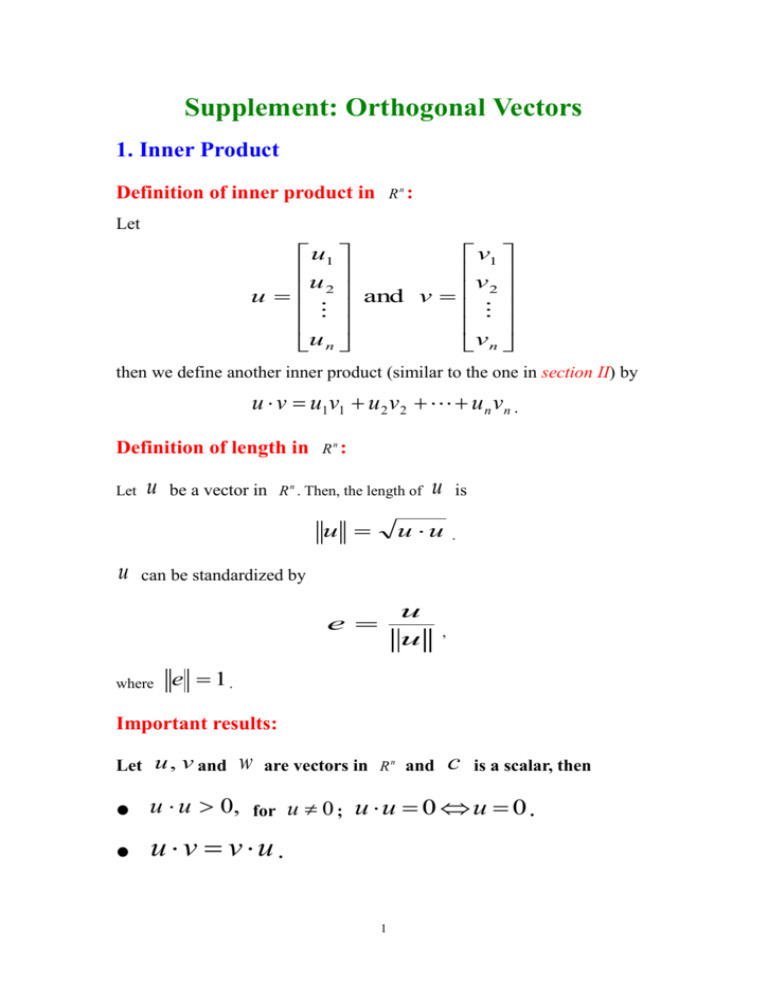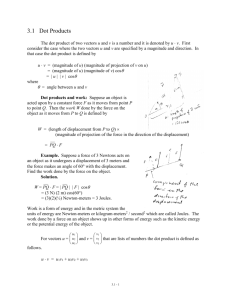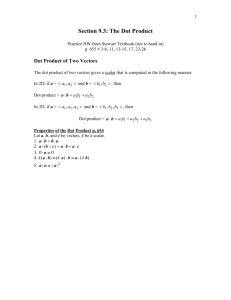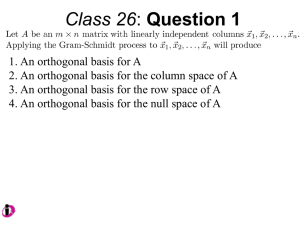Supplement: Orthogonal Vectors
advertisement

Supplement: Orthogonal Vectors 1. Inner Product Definition of inner product in Rn : Let u1 v1 u v 2 u and v 2 u n v n then we define another inner product (similar to the one in section II) by u v u1v1 u 2 v2 u n vn . Definition of length in Let u u Rn : be a vector in R n . Then, the length of u u u u e u u is . can be standardized by where , e 1. Important results: Let u , v and w are vectors in R n and u u 0, u v vu . for c is a scalar, then u 0 ; u u 0 u 0. 1 (u v) w u w v w (cu ) v u (cv) c(u v) Important results (Cauchy-Schwarz inequality): Let u , v are vectors in R n , then uv u v . Definition of angle between two vectors in The angle between two vectors cos u and v Rn : are uv , 0 u v . Example: Let 1 1 u 0 , v 0 . 0 1 Then, cos( ) uv 11 0 0 0 1 1 u v 2 12 0 2 0 2 12 0 2 12 . Thus, 4 . Definition: u and v in R n are said to be orthogonal if u v 0 u and v in R n are said to be parallel if u v u v 2 2 . 0 or Important results: Let u uv u v if and u v and be vectors in R n . Then, v are orthogonal u v 2 u 2 v . 2 2. Orthogonal Vectors: Motivating Example: 1 2 S u , u , and W span(S ) . Then, find a set of Let 1 2 0 3 orthogonal vectors which also spans W. [solution:] 2 3 u2 v2 u2 projection of u2 on v1 v1 u1 1 0 2 0 Suppose the set of orthogonal vectors is v1 ,v2 . From the above figure, we can obtain 1 v1 u1 . 0 2 2 0 v2 u 2 projection of u 2 on v1 , 3 0 3 3 where projection of u 2 on v1 u 2 cos v1 v1 u 2 v1 cos v1 2 v1 u 2 v1 v1 v1 v1 2 1 3 0 1 2 1 1 0 0 0 0 and is the angle between the vector Note: For two vectors u and u2 and v1 . v , the projection of u on v is u u projection of u on v v v projection of u on v projection of u on v u cos v v u v cos v where is the angle between the vector u and 2 v u v v vv , v. Example: 1 1 1 S u , u , u 0, 2, 2 and 1 2 3 Let 0 0 3 set of orthogonal vectors which also spans W. 4 W span (S ) . Then, find a [solution:] 1 2 0 u2 v2 u2 projection of u2 on v1 v1 u1 1 0 0 Suppose the set of orthogonal vectors is v1 , v 2 , v3 . From the above figure, we can obtain 1 v1 u1 0 . 0 1 1 0 v2 u2 projection of u2 on v1 2 0 2 , 0 0 0 where projection of u 2 on v1 u 2 cos v1 v1 u 2 v1 cos v1 2 v1 u 2 v1 v1 v1 v1 1 1 1 1 2 0 0 0 0 0 1 1 0 0 0 0 0 0 Similarly, v3 u3 projection of u3 on v1 projection of u3 on v2 1 1 0 0 2 0 2 0 3 0 0 3 5 where projection of u3 on v1 u3 cos1 v1 v1 u3 v1 cos v1 2 v1 u3 v1 v1 v1 v1 1 1 1 1 2 0 3 0 0 0 1 1 0 0 0 0 0 0 projection of u3 on v2 u3 cos 2 v2 v2 u3 v2 cos v2 2 v2 u3 v2 v2 v2 v2 0 0 1 0 2 2 3 0 2 2 0 0 2 2 0 0 0 0 , 1 is the angle between the vectors u3 and v1 , and 2 is the angle between the vectors u3 and v2 . 0 v3 u 3 - (projectio n of u 3 on v1 , v 2 ) 0 3 u3 projection of u3 0 projection of u 3 on v 2 2 0 1 projection of u 3 on v1 0 0 Therefore, 1 0 0 0, 2, 0 is a set of orthogonal vectors which spans W. 0 0 3 6 Gram-Schmidt Process: For a set of vectors u1 , u2 ,, un set of orthogonal vectors and W spanu1 , u 2 ,, u n , a v1 , v2 ,, vn which also spans W: v1 u1 v 2 u 2 projection of u 2 on v1 v3 u 3 projection of u 3 on v1 projection of u 3 on v 2 vi u i projection of u i on v1 projection of u i on v 2 projection of u i on vi 1 v n u n projection of u n on v1 projection of u n on v 2 projection of u n on v n 1 That is, v1 u1 u2 v1 v1 v1 v1 v2 u 2 vi ui ui vi 1 u v u v u v vi 1 i i 2 vi 2 i 2 v2 i 1 v1 vi 1 vi 1 vi 2 vi 2 v 2 v2 v1 v1 vn u n un vn1 u v u v u v vn1 n n2 vn2 n 2 v2 n 1 v1 vn1 vn1 vn 2 vn 2 v2 v2 v1 v1 Note: Let v1 , v2 ,, vn be an set of orthogonal vectors. Then, w1 v v1 v , w2 2 ,, wn n v1 v2 vn , are a set of orthonormal vectors. Definition of orthogonal basis and orthonormal basis: Let S v1 , v2 ,, vn and T w1 , w2 ,, wn be two bases for a vector 7 space V. Then, suppose S is a set of orthogonal vectors and T is a set of orthonormal vectors, then S is called an orthogonal basis and T is called an orthonormal basis. Important Result: Let T w1 , w2 ,, wn n be an orthonormal basis in R . If v a1 w1 a2 w2 an wn , w b1 w1 b2 w2 bn wn , then, v w a1b1 a2 b2 an bn . 8








